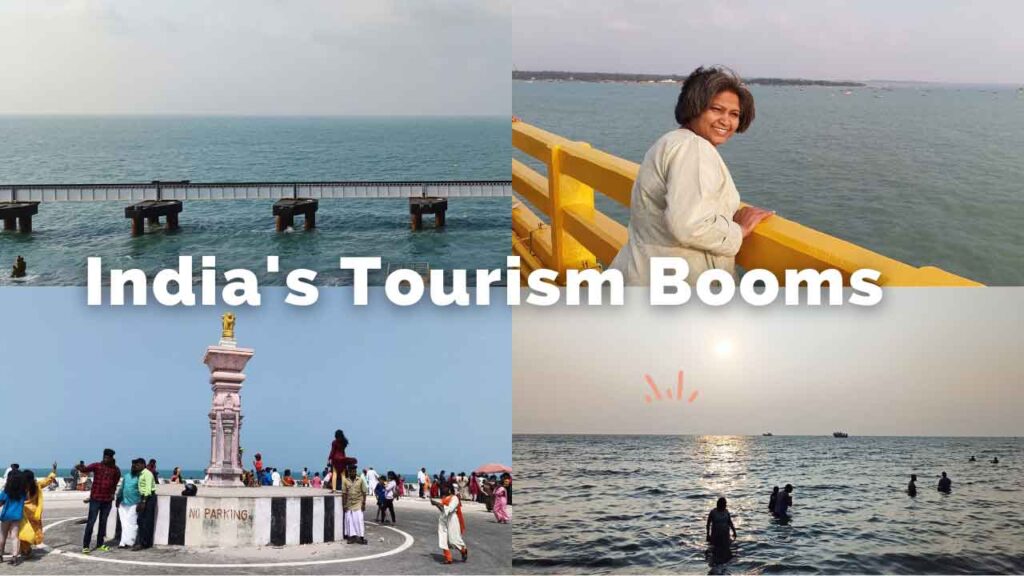India’s Tourism Industry, Its Future and Challenges

Tourism is one of the fastest growing sectors in India, contributing significantly to the country’s economy. India is a country of diverse culture, heritage, and landscapes, offering a plethora of tourism opportunities to travelers from all over the world. From the majestic Himalayan Mountains in the north to the palm-fringed beaches in the south, India has something to offer to every traveler.
The tourism industry in India is displaying signs of recovery following the COVID-19 pandemic, with a notable increase in the number of foreign tourist arrivals (FTAs) in 2022 as compared to the previous year.
According to the Bureau of Immigration, Minister of Tourism G Kishan Reddy revealed to the Parliament on Thursday (6 April) that India welcomed 6.19 million Foreign Tourist Arrivals (FTAs) in 2022.
While the number of FTAs in 2022 was less than the 10.93 million recorded during the pre-pandemic year of 2019, it was still an improvement over the 1.52 million FTAs recorded in 2021.
In a written response to a question in the Rajya Sabha, Reddy stated that foreign exchange earnings through tourism in India amounted to Rs 65,070 crore in 2021.
According to provisional figures cited by the minister in his response, foreign exchange earnings through tourism in India more than doubled to Rs 1,34543 crore in 2022.
One of the main reasons for the growth of the tourism sector in India is the government’s focus on promoting tourism through various initiatives such as the Swadesh Darshan Scheme, PRASAD Scheme, and the Incredible India campaign. The Swadesh Darshan Scheme aims to develop theme-based tourist circuits in the country, while the PRASAD Scheme focuses on developing and promoting tourism at pilgrimage sites.
The Incredible India campaign is a marketing campaign that showcases India’s cultural heritage and natural beauty to the world. The campaign has been successful in creating a positive image of India as a tourism destination and has attracted many foreign tourists to the country.
India’s tourism sector is not only limited to sightseeing and cultural tourism, but also includes adventure tourism, eco-tourism, and medical tourism. Adventure tourism includes activities such as trekking, mountaineering, and river rafting, while eco-tourism focuses on sustainable tourism practices that promote conservation and protection of the environment.
Medical tourism, on the other hand, is a rapidly growing sector in India, with many international tourists visiting the country for medical treatment at affordable prices. India is known for its world-class medical facilities and skilled medical professionals, making it an ideal destination for medical tourism.
The government of India has also been working towards developing tourism infrastructure in the country, with the construction of new airports, highways, and hotels. This has not only made travel easier and more convenient for tourists, but also created employment opportunities for the local population.
 Facts and Figures related to the tourism sector of India
Facts and Figures related to the tourism sector of India
1- According to the World Travel & Tourism Council (WTTC), the direct contribution of tourism to India’s GDP was 3.2% in 2020, and the total contribution (including indirect and induced impact) was 9.2% of GDP.
2-The tourism sector in India is estimated to generate around 40 million jobs directly and indirectly.
3-The top 10 source countries of foreign tourist arrivals in India in 2019 were Bangladesh, USA, UK, Sri Lanka, Canada, Australia, Malaysia, China, Germany, and France.
4-The top 10 states in terms of domestic tourist visits in India in 2019 were Uttar Pradesh, Tamil Nadu, Andhra Pradesh, Karnataka, Maharashtra, Delhi, West Bengal, Rajasthan, Madhya Pradesh, and Kerala.
5-India’s revenue from foreign tourist arrivals was around US$ 23 billion in 2019, and the foreign exchange earnings from tourism in India grew at a CAGR of 4.8% from 2014 to 2019.
6-According to the Ministry of Tourism, the number of foreign tourist visits to India grew at a CAGR of 7.6% from 2014 to 2019.
7-The Swadesh Darshan Scheme, launched in 2014, has sanctioned 77 projects for development of tourism infrastructure and circuits in the country with a total cost of Rs. 6,035.70 crore.
8-The PRASAD Scheme, launched in 2014, has sanctioned 28 projects for development of pilgrimage sites in the country with a total cost of Rs. 727.16 crore.
9-India has a total of 38 world heritage sites recognized by UNESCO, including iconic landmarks such as the Taj Mahal, Red Fort, and the Khajuraho temples.
10-The medical tourism sector in India was estimated to be worth around US$ 3 billion in 2019, with an expected growth rate of 15% CAGR from 2020 to 2025.
These figures highlight the significant contribution of the tourism sector to India’s economy and the potential for further growth in the industry.
Tourist Circuits of India
India has numerous tourist circuits that offer visitors an opportunity to explore the diverse cultural, natural, and historical attractions of the country. Here are some of the most popular tourist circuits in India:
1- Golden Triangle Circuit: This circuit covers the cities of Delhi, Agra, and Jaipur and is popular for its rich cultural heritage and historical significance. The Taj Mahal, Red Fort, and Amer Fort are some of the major attractions.
2-Rajasthan Circuit: This circuit covers cities such as Jaipur, Jodhpur, Udaipur, and Jaisalmer, and offers visitors an opportunity to explore the majestic forts, palaces, and rich cultural heritage of the region.
3- South India Circuit: This circuit covers the states of Tamil Nadu, Karnataka, and Kerala and is known for its beautiful temples, stunning beaches, and lush greenery. The backwaters of Kerala, Meenakshi Temple in Madurai, and the ruins of Hampi are some of the major attractions.
4- Northeast India Circuit: This circuit covers the states of Assam, Meghalaya, Arunachal Pradesh, and Nagaland, and offers visitors an opportunity to explore the stunning natural beauty of the region, including the Brahmaputra River, Kaziranga National Park, and the living root bridges in Meghalaya.
5- Wildlife Circuit: This circuit covers various wildlife reserves and national parks across India, including Jim Corbett National Park, Kanha National Park, and Bandhavgarh National Park. Visitors can experience a wide variety of flora and fauna, including tigers, elephants, and rhinoceros.
6- Spiritual Circuit: This circuit covers various spiritual and religious destinations across India, including Varanasi, Bodh Gaya, and the Golden Temple in Amritsar. Visitors can experience the rich spiritual heritage of India and participate in religious and cultural activities.
7- Coastal Circuit: This circuit covers the coastline of India, from Gujarat in the west to West Bengal in the east, and offers visitors an opportunity to explore the stunning beaches, forts, and temples along the coast.
These are just a few of the many tourist circuits in India that offer visitors a chance to explore the diverse culture, history, and natural beauty of the country.
Famous Tourist Places in India
India is a land of diverse culture, history, and natural beauty, and it offers an endless list of tourist destinations to explore. Here are some of the most famous tourist places in India:
1- Taj Mahal, Agra: One of the Seven Wonders of the World, the Taj Mahal is an iconic monument and a UNESCO World Heritage site.
2- Jaipur, Rajasthan: Also known as the ‘Pink City,’ Jaipur is famous for its magnificent palaces, forts, and rich cultural heritage.
3- Kerala Backwaters: The serene backwaters of Kerala offer a unique experience of cruising on traditional houseboats, enjoying the scenic beauty and local cuisine.
4- Goa: Known for its beaches, nightlife, and vibrant culture, Goa is a popular destination for domestic and foreign tourists alike.
5- Ladakh, Jammu and Kashmir: This high-altitude desert region in the Himalayas is famous for its stunning natural beauty, ancient monasteries, and adventure activities like trekking and river rafting.
6- Varanasi, Uttar Pradesh: One of the oldest cities in the world, Varanasi is known for its ancient temples, the sacred River Ganges, and spiritual practices like yoga and meditation.
7- Khajuraho Temples, Madhya Pradesh: These ancient temples are famous for their exquisite sculptures and intricate carvings that depict human emotions and relationships.
8- Hampi, Karnataka: This UNESCO World Heritage site is home to the ruins of the Vijayanagara Empire, showcasing stunning architecture, temples, and a vibrant market.
9- Mysore Palace, Karnataka: The Mysore Palace is a stunning example of Indo-Saracenic architecture, and it is one of the most popular tourist attractions in India.
10- Darjeeling, West Bengal: This hill station is famous for its scenic beauty, tea plantations, and panoramic views of the Himalayan mountain range.
These are just a few of the many famous tourist destinations in India, and there are countless others waiting to be explored.
Future of Indian Tourism Sector
The future of Indian tourism sector looks promising, as the government is taking several initiatives to promote tourism and improve infrastructure.
Here are some key factors that are expected to drive the growth of Indian tourism sector in the future:
1- Rising disposable incomes and changing lifestyles of the Indian middle class are expected to drive the domestic tourism market.
2- The government’s focus on improving infrastructure, such as airports, highways, and railways, is expected to boost tourism.
3- The government’s ‘Atithi Devo Bhava’ campaign, which aims to create a hospitable environment for tourists, is expected to improve the overall tourism experience.
4- The government’s initiatives to promote eco-tourism and adventure tourism, such as the development of national parks and wildlife reserves, are expected to attract more tourists.
5- The increasing popularity of digital platforms for travel planning and booking is expected to drive growth in the online travel market.
6- The government’s initiatives to promote sustainable tourism and responsible tourism practices are expected to improve the environmental and social impact of tourism.
7- The growing popularity of medical tourism, as India has become a popular destination for affordable healthcare services, is expected to drive growth in this segment.
Overall, the future of Indian tourism sector looks promising, and with the right policies and investments, India can become a major tourist destination in the world.
Challenges of India’s Tourism Industry
However, the tourism sector in India is not without its challenges. One of the main challenges faced by the industry is the issue of safety and security of tourists. Incidents of harassment and theft have been reported in certain parts of the country, which can deter tourists from visiting these areas.
Another challenge faced by the industry is the lack of trained professionals in the tourism sector. The industry requires skilled manpower in areas such as hospitality, tour guiding, and travel management, which can be a bottleneck in the growth of the sector.
In conclusion, the tourism sector in India has immense potential for growth, with the country’s rich cultural heritage and natural beauty attracting millions of tourists every year. The government’s focus on promoting tourism through various initiatives and the development of tourism infrastructure in the country has contributed to the growth of the industry. However, the industry must address the challenges faced by it to ensure sustainable growth in the future.











